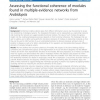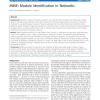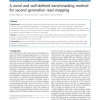13090 search results - page 2610 / 2618 » Usable artificial intelligence |
BMCBI
2011
13 years 14 hour ago
2011
Background: Combining multiple evidence-types from different information sources has the potential to reveal new relationships in biological systems. The integrated information ca...
BMCBI
2011
13 years 14 hour ago
2011
Background: Pairwise sequence alignment methods are widely used in biological research. The increasing number of sequences is perceived as one of the upcoming challenges for seque...
BMCBI
2011
13 years 14 hour ago
2011
Background: Using microarray and sequencing platforms, a large number of copy number variations (CNVs) have been identified in humans. In practice, because our human genome is a d...
BMCBI
2011
13 years 14 hour ago
2011
Background: Graphical models of network associations are useful for both visualizing and integrating multiple types of association data. Identifying modules, or groups of function...
BMCBI
2011
13 years 14 hour ago
2011
Background: Second generation sequencing technologies yield DNA sequence data at ultra high-throughput. Common to most biological applications is a mapping of the reads to an almo...



